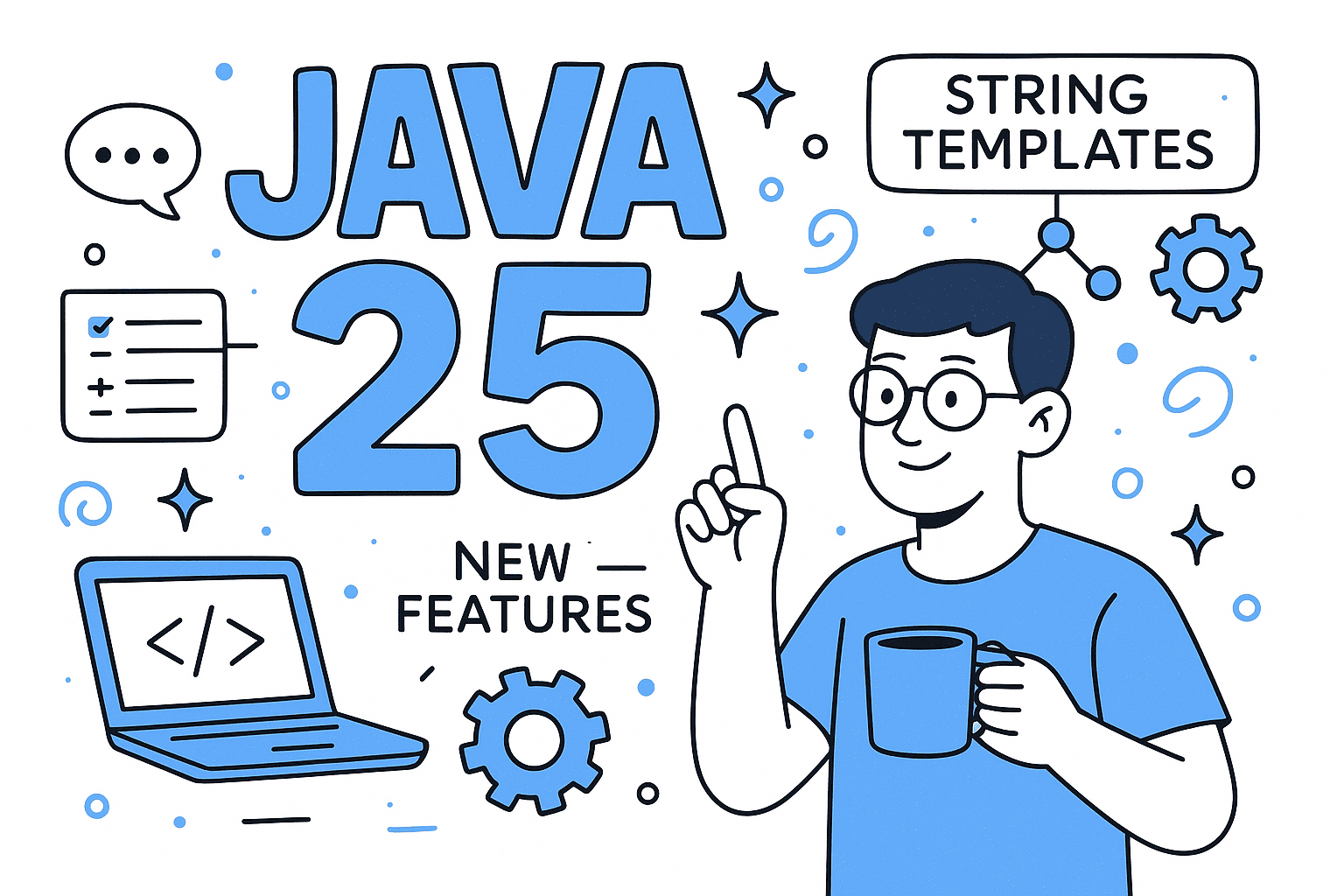Java 25 is here, and it brings a mix of language enhancements, JVM improvements, and new APIs that developers should care about. Unlike minor updates, Java 25 continues the tradition of polishing modern Java while also laying the groundwork for performance and developer productivity.
In this article, we’ll explore what’s new, why it matters, and demonstrate the improvements with before vs. after code examples.
🚀 Key Highlights of Java 25
- Streamlined Pattern Matching: Pattern Matching becomes more powerful and reduces boilerplate.
- String Templates (Standardized): First introduced as a preview, string templates are now polished.
- Scoped Values and Virtual Threads: Improved support for structured concurrency and lightweight thread data handling.
- New APIs & Enhancements: Small but impactful libraries improvements across Collections, Records, and Foreign Function & Memory API.
- JVM Performance Updates: Optimizations for garbage collection, startup, and JIT compilation.
🧩 Pattern Matching Improvements
Pattern Matching is becoming the norm in modern Java.
Before (Java 21):
if (obj instanceof String) {
String s = (String) obj;
if (s.length() > 5) {
System.out.println("Long string: " + s);
}
}
After (Java 25):
if (obj instanceof String s && s.length() > 5) {
System.out.println("Long string: " + s);
}
Cleaner, safer, and more readable. Nested patterns are also easier to handle with less boilerplate.
💡 String Templates
String concatenation and String.format have long been clunky. Java 25 stabilizes string templates.
Before (Java 21):
String name = "Alice";
int age = 30;
String msg = String.format("User %s is %d years old", name, age);
After (Java 25):
String name = "Alice";
int age = 30;
String msg = STR."User \{name} is \{age} years old";
This feels natural, closer to JavaScript template literals and more concise.
🧵 Scoped Values + Virtual Threads
Scoped values make it easier to share immutable data across threads without relying on ThreadLocal. Paired with virtual threads (introduced in Java 21, now more mature), this simplifies concurrency.
Before (with ThreadLocal):
ThreadLocal<String> userContext = new ThreadLocal<>();
userContext.set("Alice");
new Thread(() -> {
System.out.println("User: " + userContext.get());
}).start();
After (Java 25 Scoped Values):
import java.lang.ScopedValue;
static final ScopedValue<String> USER = ScopedValue.newInstance();
ScopedValue.where(USER, "Alice").run(() -> {
Thread.ofVirtual().start(() -> {
System.out.println("User: " + USER.get());
});
});
Scoped values provide cleaner, safer context propagation—especially for microservices and reactive apps.
📚 API Refinements & FFM (Foreign Function & Memory)
The Foreign Function & Memory API continues to evolve in Java 25, allowing Java to call native libraries directly without JNI pain.
Example (simplified):
import java.lang.foreign.\*;
import java.lang.invoke.MethodHandle;
try (Arena arena = Arena.openConfined()) {
MemorySegment cString = arena.allocateUtf8String("Hello, C!");
// Call C functions directly here...
}
This unlocks performance-critical integrations with C/C++ libraries and even ML frameworks.
⚡ JVM & Performance
- Garbage Collection (GC): G1 and ZGC tuned for lower latency.
- JIT Optimizations: Smarter inlining and profiling for modern workloads.
- Startup Improvements: Faster warm-up for containerized/cloud apps.
🔮 Why Developers Should Upgrade to Java 25
- Less Boilerplate: cleaner code with patterns and string templates.
- Better Concurrency: virtual threads + scoped values = simpler scaling.
- Native Interop: Foreign Function & Memory is production-ready.
- Performance Gains: JVM improvements help microservices and large-scale apps.
If you’re on Java 17 (LTS) or Java 21 (LTS), Java 25 offers enough productivity and performance boosts to justify trying it out—especially in dev/test environments.
📝 Final Thoughts
Java 25 proves the language is not just alive but thriving, competing with modern ecosystems while retaining its strengths.
If you’re a developer building APIs, cloud-native apps, or performance-heavy workloads, Java 25 is worth your attention. The combination of cleaner syntax, modern concurrency, and faster runtime makes it one of the most developer-friendly updates in years.
🤝 Need a Custom RSVP System or Dashboard?
I help businesses build tools that actually work , even on tight deadlines.
Whether you're planning an event, need internal tools, or want a custom dashboard for your team , I can help.
Reach out
📧 Email: safi.abdulkader@gmail.com | 💻 LinkedIn: @abdulkader-safi | 📱 Instagram: @abdulkader.safi | 🏢 DSRPT
Drop me a line, I’m always happy to collaborate! 🚀


